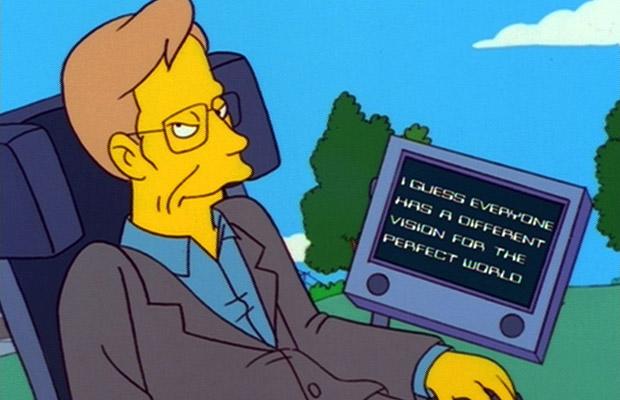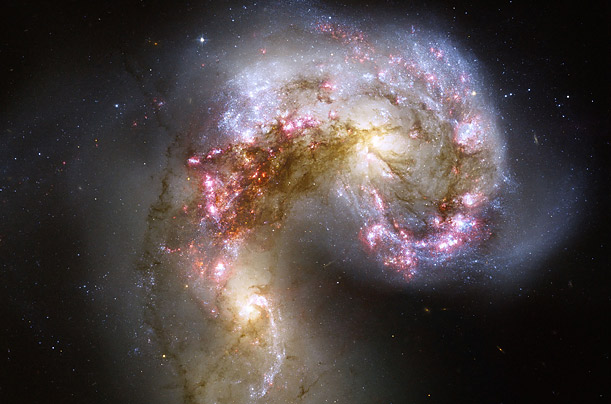“If DAMA’s signal were due to dark matter, Xenon 100 would have seen dozens of events — unless the properties of dark matter are very different than expected, says Lang. ‘If DAMA really does see dark matter, it has to be something very, very exotic, something much different from what we expect, so it’s getting a bit unlikely.‘” A new study casts doubt on apparent discoveries of dark matter particles by the DAMA experiment. Back to MOND, then?
Tag: The Universe
Good Fences Make Good (Intergalactic) Neighbors.

Twenty Years of Hubble.

Shedding Light on (a) Dark Matter?
“The second law states that a force is proportional to an object’s mass and its acceleration. But since the 1980s, some physicists have eyed the law with suspicion, arguing that subtle changes to it at extremely small accelerations could explain the observed motion of stars in galaxies.” Also on the subject of spinning, a new experiment finds a way to test Modified Newtonian Dynamics (MOND) on Earth, which, if successful, could revise Newton’s heretofore ironclad 2nd law…and explain away the longstanding dark matter problem. (By way of my new favorite Twitter feed, @newscientist.)
A Hot Mess.
“‘There’s going to be all kinds of weird stuff out there,’ said Alan Boss of the Carnegie Institute of Washington, who wasn’t part of the research. ‘This is an unparalleled data set. The universe really is a weird place. It’s fantastic.’” In the midst of its current planet–hunting sweep, NASA’s Kepler telescope discovers two examples of a new type of heavenly body that are “too hot to be planets and too small to be stars.” (Although some think they’re recently-born planets; others dying “white-dwarf” stars.) “‘The universe keeps making strange things stranger than we can think of in our imagination,’ said Jon Morse, head of astrophysics for NASA.”
SETI 2.0.
“‘We’ve looked at far, far fewer than 10 million stars since 1960, and so we really can’t say anything worthwhile yet about whether or not intelligent life is out there,’ Drake said. ‘Given our capabilities now, we might have something useful to say one way or another in 25 years.'”
In the wake of all these new planets, the WP takes a gander at the new and improved SETI program. “‘We’re finding new extra-solar planets every week,’ she said. ‘We now know microbes can live in extreme environments on Earth thought to be impossible for life not very long ago, and so many more things seem possible in terms of life beyond Earth.’”
Next Stop, Alderaan.
“‘We are still coming to terms with just how smooth the LHC commissioning is going,’ said CERN Director General Rolf Heuer as the record was announced. ‘It is fantastic.’” Atoms or systems into ruin hurl’d, And now a bubble burst, and now a world…Also in science news, the now armed and fully operational Large Hadron Collider is breaking particle beam records as it warms up for the Big Show, when its handlers will work to recreate the conditions at one billionth of a second after the Big Bang. “Said Heuer: ‘We are continuing to take it step by step, and there is a lot to do before we start [first] physics in 2010. I’m keeping my champagne on ice until then.’” (By way of Dangerous Meta.)
Grasp of Thanos.

The Great Churning.
“‘There is ‘something new and interesting going on in the universe,’ said Alan Kogut of NASA’s Goddard Space Flight Center in Greenbelt, Md.” Aspiring Jor-Els: Best get to work on those interstellar child-bearing rockets. Scientists detect a distant — and very loud — roar on the other side of the universe. “‘The universe really threw us a curve,’ Kogut said. ‘Instead of the faint signal we hoped to find, here was this booming noise six times louder than anyone had predicted.’” (Sssh, listen…there went Earth-2.)
A Measure of Darkness.
“‘We’ve discovered this incredible dark energy, we don’t understand what the hell it is,’ said Lawrence Krauss, a physicist at Arizona State University. ‘It’s extremely small, extremely weak, and it’s so close to being zero, it’s just a total mystery why it should have this small value and not be zero.” While they’re still not entirely sure what in fact they’re looking at, Harvard-Smithsonian astrophysicists announce they’ve found another way to measure and quantify “dark energy”, a.k.a. the repulsive “cosmological constant” force causing the universe to expand rather than contract. “This is a much-needed confirmation that the earlier work was correct, the astronomers said, comparing it to football referees examining a controversial play with multiple camera angles.“
As an added bonus, the results announced today also seem to confirm Einstein’s general theory of relativity. “‘It’s never been proved right on the scale of the observable universe,’ Spergel said.”
